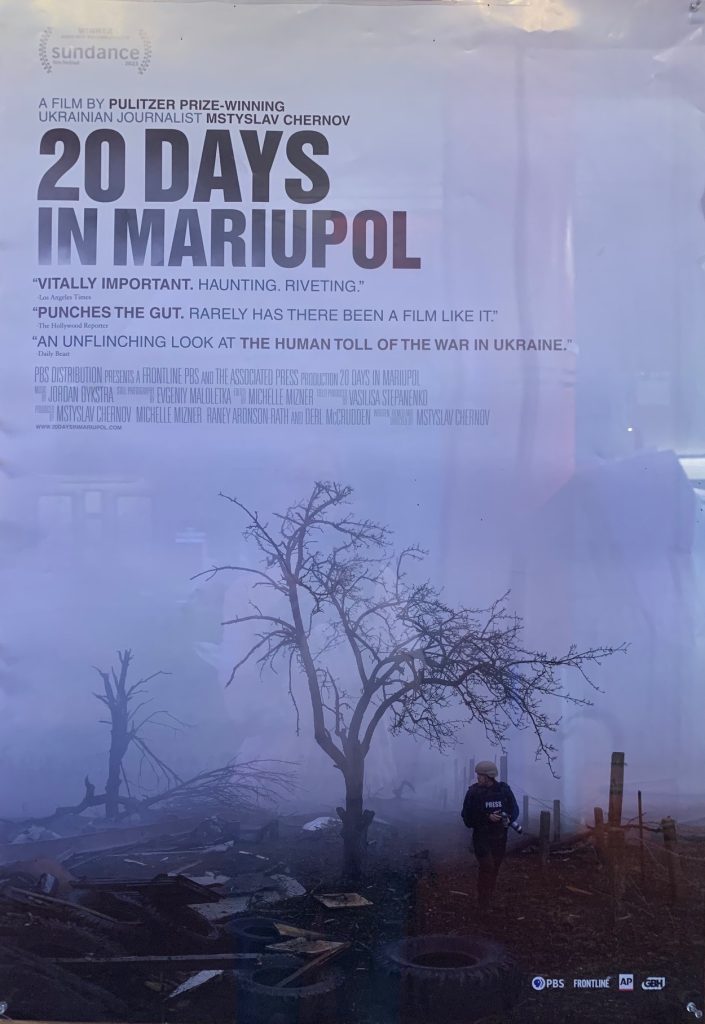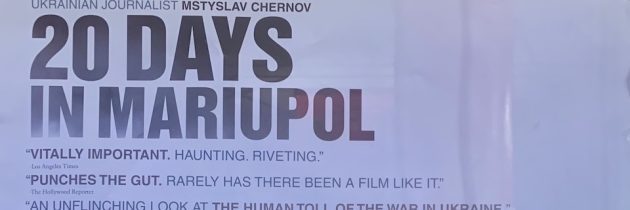20 Days in Mariupol: Guest Review by Walter Adamson
Walter Adamson is a professor emeritus of European history at Emory University and a devoted observer of our current geopolitical situation. Many of you have read his previous post describing Benito Mussolini’s 1922 March on Rome and comparing the century-old insurrection to the assault on the U.S. Capitol on January 6, 2021 in order to keep election loser Donald Trump in office. Today he returns with a review of Mstyslav Chernov’s documentary film 20 Days in Mariupol, a chronicle of the city’s destruction in the first days of Russia’s full-scale invasion of Ukraine. The film premiered at the Film Forum in New York City and is currently touring the country.
*
 Franz Kafka’s diary entry for August 2, 1914, famously states: “Germany has declared war on Russia. Swimming school in the afternoon.” No such leisure greeted the residents of Mariupol, Ukraine, on February 24, 2022, as they awoke to hear deafening explosions from Russian rocket attacks. Yet the transition from Putin’s sinister blustering to air raid sirens was no less swift.
Franz Kafka’s diary entry for August 2, 1914, famously states: “Germany has declared war on Russia. Swimming school in the afternoon.” No such leisure greeted the residents of Mariupol, Ukraine, on February 24, 2022, as they awoke to hear deafening explosions from Russian rocket attacks. Yet the transition from Putin’s sinister blustering to air raid sirens was no less swift.
Viewers of AP journalist Mstyslav Chernov’s brilliant new documentary, 20 Days in Mariupol, witness a hellish panorama of video clips and images that record the breathtakingly sudden onset of war. We see the attacks from the vantage point of individuals and families living their lives. They move to crowded, make-shift bomb shelters and sleep with their neighbors as the rubble accumulates outside. Soon cell phones become useless except (if a generator can be found) as flashlights. Children continue to play outside but at their peril. We see a teenaged soccer player whose knees turn into bloody stumps when a bomb explodes nearby.
The film crew takes us inside local hospitals where the staff screams and races to keep up with the incoming injured in a desperate struggle to save them from becoming deaths. Needless to say, the efforts often fail. We see a four-year-old boy die on the operating table before his wailing parents. Then the crew moves to a maternity hospital, and when a bomb suddenly strikes, we see a woman in the midst of giving birth rushed outside on a stretcher – but too late to save either her or the baby. We see the bodies from the hospitals and elsewhere being packed into black trash bags and dropped into newly dug ditches, one on top of or beside the other. We also see opportunistic people looting and a woman screaming at the thieves.
Many of these scenes are filmed in long takes so that we feel as though we are there along with the film crew and the residents. We almost become participants in the wailing and the shrieking. When a livid hospital surgeon turns to the camera to berate the Russian military, we feel that he is speaking directly to us. And when the film crew discovers that, in their zeal to capture the events, they have now fallen behind enemy lines, we feel we are with them as they make their daring and treacherous escape.
Yet, to my mind, the most provocative aspect of the film is the way it captures the suddenness of the transition from normal life on February 24. As I watched those early scenes, I found myself imagining how I would answer if my children were to ask, what did we do with our cat Ihor? Or what about my cello lesson with Daryna tomorrow? Did we bring the box of Cheerios? When can we go home?
As I left the theater, I felt such a huge rush of anger engulfing me that I did not at first recognize a friend I happened to bump into. And then I went home myself. As I looked out over the large marsh that I see from my deck, ducks were swimming together in the creek. Egrets were feeding themselves on tadpoles in the tall grass. The osprey were hanging out in their nest. Reeds were swaying in the breeze. I mused that it was my version of swimming in the afternoon. But the scenes from Ukraine were indelible and impossible to dismiss. And I soon remembered what director Chernov had said at the outset of the film: “This is painful to watch; but it must be painful to watch.”
*
For more information on how to help Ukrainians caught up in this war, see this post with a list of organizations providing aid to civilians living within the country and outside as refugees.







Someone else mentioned this documentary to me last week. So how timely that this post is about that!
After Walter told me about the film, I saw it and agree with everything he said. As a follow up, I’m currently reading an account of the bombing of Kharkiv in the early days of the war and will be writing a review of that book in the context of the film. The book focuses more on the resistance which, as we later know, will turn out to be more successful there.